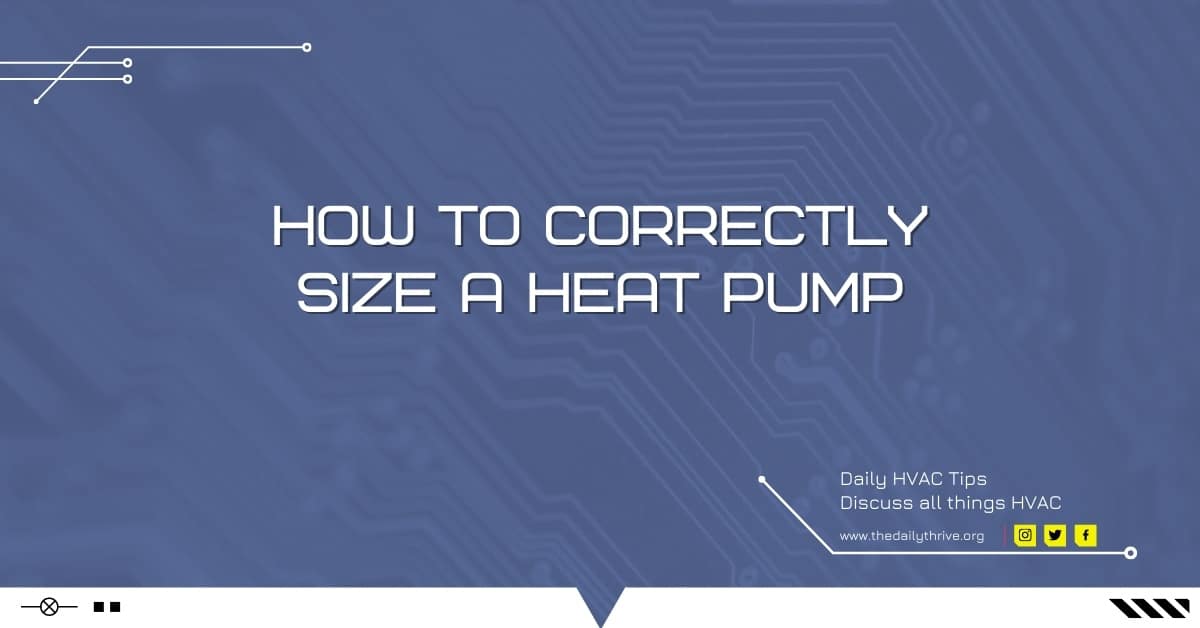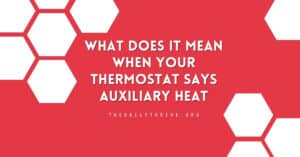There is no simple equation to decide what size heat pump do i need to put in a some 2500 sq home. The best possible way of ensuring that your Heat Pump is sized correctly is by working with a qualified and experienced HVAC technician. They have the experience to make sure your heat pump is big enough and will be properly installed and set up to be as reliable and energy efficient as possible.
One of the biggest problems that homeowners (unknowingly) face is that their homes are fitted with heat pumps that are seriously oversized. Problem which costs them much more than they should be paying and in turn generates a bigger income for someone who wanted to make a quick buck by selling them an oversized unit.
Sizing is probably the single most important factor when you’re considering getting the best heat pump installed. A full heat load analysis should be conducted before your contractor decides on a size of heat pump as this will significantly affect the efficiency of your heat pump.
When a technician starts calculate heat pump size, he starts by determining your required cooling capacity.
How To Correctly Size A Heat Pump
The first step in determining what size of heat pump your home need is to determine the required cooling capacity, just like they would for any air conditioning system.
Heat pump capacity is measured in 2 ways:
- BTUs (British Thermal Units)
One BTU is the amount of heat required to heat one pound of water 1°F, or approximately the amount of heat generated by burning a single match. Most residential heat pumps typically range from 12,000–60,000 BTUs. - Tonnage
Tonnage (also called “ton”) is another measurement of heat energy. One “ton” is the amount of heat needed to melt one ton of ice in 24 hours. One ton is equivalent to 12,000 BTUs, so residential heat pumps range from 1 to 5 tons.
Most manufacturers of Heat Pumps make their products available in several different sizes ranging from 1.5 to 5 tons of capacity. This measurement was originally referred to as the amount of ice needed to cool the equivalent amount of air. Your typical residential home uses (again under normal circumstances) a 3 ton Heat Pump to efficiently heat up the house.
The Manual J Calculation
The best way to determine what size heat pump do i need is to have a Manual J calculation. The Manual J calculation is by now the most precise measurement available because it considers factors like:
- Square footage
- Climate zone
- Ductwork
- Number and style of windows
- Natural shade or sunlight
- Quality and amount of insulation
- Number of people using the space
- Heat-generating appliances
A Rough Estimate
Like we mentioned before, figuring out the required size of a heat pump is something that a professional HVAC contractor should do, but you can easily figure out a rough estimate of what size heat pump you’ll need. This heat pump sizing rule is fairly simple to use:
- What size heat pump for 1,000 sq ft = 2 ton
- What size heat pump for 1,500 sq ft = 3 ton
- What size heat pump for 2,000 sq ft = 4 ton
- What size heat pump for 2,500 sq ft = 5 ton
- What size heat pump for 3,000 sq ft = 6 ton
30 BTU of heating output per 1 sq ft of living space
A 500 square feet of living space would need a 1 ton heat pump to be warmed up effectively. So if you have a 2,000 square foot house, you would probably need a 4 ton heat pump system to efficiently heat up the home.
That heat pump calculation based on older homes though and some of the newer houses that have double-paned windows and extra insulation would easily be able to get away with a smaller system.
Calculate the Heat Loss
There are a couple of ways to do this, the first is to get a professional home energy auditor to calculate this for you. A home energy auditor will charge between $300-$1000 – if you have an older home this will usually pay for itself.
It’s an added bonus if you’re looking at installing a new heating & cooling system which will help you make an informed decision about which size of unit to use.
Calculating heat loss on your own.
- First determine the design temperature. If you live in the US you’re in luck you can find design temperatures in various cities.
- Next we choose our indoor design temperature. Your indoor design temperature is all about your personal comfort. I normally use 72F – that’s where I feel the most comfortable. The standard is to use 70F.
- Determine the U values (you can visit this site out to learn how to calculate U values)
- Heat loss (Q) = Delta T (X) Area (X) U. Delta T is the difference between the indoor and outdoor design temperature.
- Next we calculate infiltration losses (your head hurting yet?) This is normally done by a computer, we’ll get to that. By hand, the formula is Q=V*ACHn*.018*ΔT. V is the volume of a room, ACH is the air changes per hour, 0.018 is the heat capacity of air and delta T is the difference in temperature. ACH is normally calculated by performing a blower test.
- Ventilation is the same formula the only difference being you need to adjust it for the heat recovery unit. For example if you it’s 60% efficient your ΔT is going to be ΔT * 40% (the amount of heat lost).
Cost To Run Heat Pump
How much cost to run heat pump and electricity will you use with a heat pump? The exact electricity use will vary from home to home based on many factors. A rough guide to help you determine the heat pump cost will looks something like this:
Supplemental Heating Element Kw by climate and Tonnage:
Very warm winter climates (Average low winter temperatures of 35 degrees and up)
- 1.5 – 3.0 tons Heat Pump – Use a 5 Kw
- 3.5 – 5.0 tons Heat Pump – Use a 10Kw
Mild winter climates (Average low winter temperatures of 25 degrees and up)
- 1.5 – 2.0 tons Heat Pump – Use a 5 Kw
- 2.5 – 5.0 tons Heat Pump – Use a 10Kw
Colder winter climates (Average low winter temperatures of 0 degrees and up)
- 1.5 – 2.5 tons Heat Pump – Use a 10 Kw
- 2.5 – 3.5 tons Heat Pump – Use a 15 Kw
- 4.0 – 5.0 tons Heat Pump – Use a 20 Kw
Coldest winter climates (Average low winter temperatures of -10 degrees and up)
- 1.5 – 2.0 tons Heat Pump – Use a 10 Kw
- 2.5 – 3.0 tons Heat Pump – Use a 15 Kw
- 3.0 – 5.0 tons Heat Pump – Use a 20 Kw
Oversized Heat Pumps
WHY heat pumps are so often oversized. It comes down to three factors – money, comfort and a margin for error.
Often times contractors will push more expensive systems because they’re more expensive for them to install. If a contractor has set his materials markup to be 10% which would they rather install – a $2000 unit or a $8000 unit?
That’s a $600 difference! Now of course that’s extreme and most contractors aren’t crooks but let’s face it if someone is on the fence between suggesting unit A versus unit B and unit B will earn them an extra few hundred dollars it’s difficult to present an unbiased opinion.
Earlier I discussed how you need to get a manual J calculation done and if a contractor is unwilling to perform one show them the door. Of course, just because a contractor does a manual J calc, it doesn’t mean it’s going to be correct.
Often times instead of designing for ‘design temperatures’ they design for ‘extreme temperatures’.
Your contractor should be designing his HVAC equipment to meet the 99% not the 1%. There will be a few hours each year when your system will have troubles keeping up. Having a heat pump which can’t meet the load 1% of the year is a much better alternative than a heat pump that is oversized.
I’m sure most HVAC professionals are aware of this, however they probably receive a ton of calls as soon as the temperatures become extreme (the 1%). This results in a tendency to oversize.
The Issues With Oversized Heat Pumps
The most obvious issue – you’re going to pay more. If you need to install a 3 ton unit instead of a 2.5 tonne unit you’re paying more. It’s that simple, it’s not a lot more but it is more.
The less obvious problem with an oversized heat pump is something called short cycling. Basically, because the capacity is too high for the space and it is constantly kicking in and out trying to maintain your desired temperature.
When a heat pump is only allowed to run for very short periods of time your home won’t be dehumidified. A space that is excessively humid isn’t going to be very comfortable. Also, the constant starting and stopping is going to lead to higher energy bills and a short life for your heat pump.
Conclusion
Doing a calculation with software like heat pump size calculator will help you understand the process that your contractor should be using to determine the size of your heating and cooling equipment. If there are any large discrepancies this will give you the ability to talk about it in an educated manner.
Again, sizing a heat pump is not easy. My recommendation is to hire an experienced HVAC technician who will take the variables into account. Collect several quotes and compare the price estimations.






